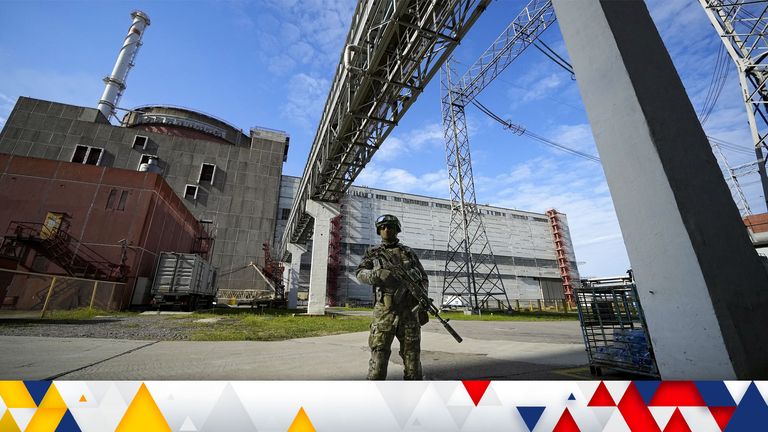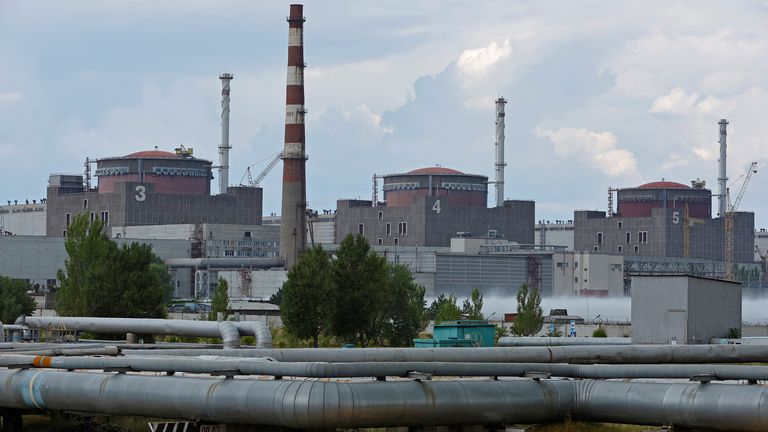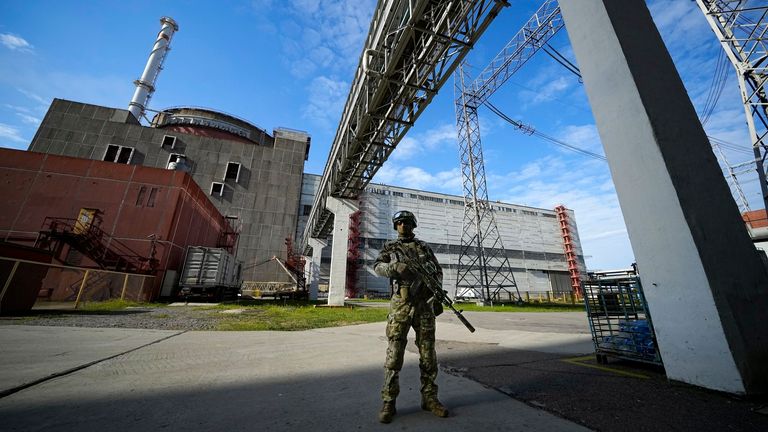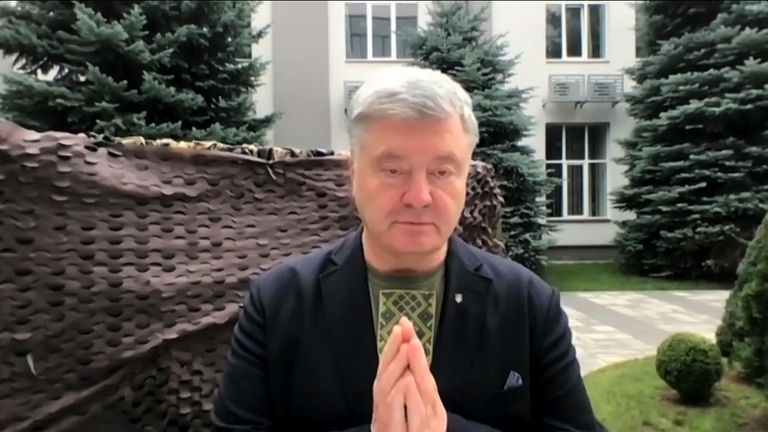Ukraine war: What are the risks of a nuclear accident at the Zaporizhzhia nuclear power plant amid the war with Russia?
Ukraine's defence intelligence agency said Russia was preparing new "provocations" at Europe's biggest nuclear plant, saying Russian troops had placed a Pion self-propelled howitzer outside the nearby town and put a Ukrainian flag on it.
Monday 22 August 2022 07:43, UK
Ukraine's defence intelligence agency has warned of fresh Russian "provocations" at the occupied Zaporizhzhia nuclear plant in southern Ukraine, while a mayor said the city where the power station is based had come under fresh shelling.
Rafael Grossi, director-general of the International Atomic Energy Agency (IAEA), has described recent shelling at Europe's biggest nuclear plant as "out of control" and "extremely serious".
The violence there amid the war in Ukraine "underlines the very real risk of nuclear disaster", according to the United Nations watchdog.
Strikes 'hit Crimea' - follow Ukraine updates live
While Russia and Ukraine blamed each other - accusing the other side of "nuclear terrorism" - UN secretary-general Antonio Guterres visited the site in a bid to deescalate tensions.
Experts, meanwhile, warn that the plant getting caught up in the conflict could result in a nuclear accident similar to the one in Fukushima, Japan in 2011.
What's the latest?
Exiled Enerhodar mayor Dmytro Orlov said local residents had told him of fresh Russian shelling in the direction of the city's industrial zone and the Zaporizhzhia plant. It was not clear if any shells hit the grounds of the plant.
Local Russian-installed official Vladimir Rogov wrote on Telegram that Ukrainian forces were shelling the plant.
"According to witnesses, explosions can be heard again in the town," Mr Rogov said, adding that shells had landed in the vicinity of the power station, without specifying if it had hit the plant's territory.
Ukraine's defence intelligence agency said Russia was preparing new "provocations" at the plant, saying Russian troops had placed a Pion self-propelled howitzer outside the nearby town and put a Ukrainian flag on it.
Earlier this month, shelling near Enerhodar hit a high-voltage power line that feeds into the nearby nuclear power plant, Reuters reported.
Although officials confirmed there were no radioactive leaks as a result, it saw operators disconnect one of the site's reactors as a safety measure.
The following day, Ukraine's nuclear operator Energoatom said Russian missiles damaged three radiation monitors at the plant's storage facility for spent nuclear fuels. One worker was injured, they added.
Russia's Interfax news agency said that Ukrainian forces fired the shells and that they only hit one of the site's administration buildings.
What's the background?
There have been a number of reports of missile fire at the plant since the war began.
In the early hours of 4 March, soon after the Russians invaded, a missile hit a training building and set it on fire.
The Ukraine State Emergency Service soon reported that operators had shut down one of the nuclear reactors as a precaution, but radiation levels were normal and no key infrastructure had been damaged.
Zaporizhzhia is home to six nuclear reactors, making it the largest plant in Europe.
It has a capacity of six gigawatts, which is enough energy to power four million homes and sits near the Dnipro River in southwest Ukraine.
Experts believe only three of the reactors have been in use since the Russians invaded, with Ukrainian staff still working there - but under duress.
Reactors could 'withstand a plane crash'
The reactor is the heart of any nuclear power plant. Here, controlled nuclear reactions create enough heat to turn water into steam, which is then used to create energy.
There are two types - boiling water reactors and pressurised water reactors.
Zaporizhzhia is home to the latter, which are much safer than the former ones used at the Chernobyl site, where the 1986 disaster resulted in a huge radiation leak and dozens of direct and indirect deaths.
Professor Claire Corkhill, chair in nuclear material degradation at the University of Sheffield, told Sky News: "After Chernobyl, there were lots of lessons learned.
"One of the main ones was that reactors should be contained in very robust buildings, so now they are built in huge reinforced concrete containers.
"A plane could fly into those buildings and they wouldn't be damaged."
The reactors also feature built-in fire defences and if the electricity supply to them fails, they have back-up generators powered by diesel that last around three days.
Other infrastructure still at risk
There are still other parts of the plant that are vulnerable to damage, however.
Once the radioactive fuel inside the reactor has been used to its full capacity it is placed in a large cooling pond for around two years before being transferred to a dry storage facility.
According to Ukrainian nuclear regulator Energoatom, earlier strikes damaged three radiation monitors at one of the storage facilities for spent fuel.
Professor Corkhill says: "A missile strike to the cooling pond building is of concern as the water is highly radioactive and a leak could spread radioactivity in the local area.
"A strike to the dry cask storage is less concerning, as the nuclear fuel is well protected by thick metal and concrete containers."
Professor Malcolm Sperrin, director of the department of medical physics and clinical engineering at Oxford's NHS Trust, adds that a release of radioactive substance from a cooling pond or laboratory outside the reactor "does create the potential for risk to surrounding countries - but not on the scale of Chernobyl".
Each strike removes a vital safety defence
When earlier this month shelling hit a power line to the plant, the reactor was shut down as a safety measure.
But Tony Roulstone, lecturer in nuclear energy at Cambridge University, cautions that in the context of a war, once on-site, back-up diesel supplies run out, getting more could prove difficult.
"There are in-depth defences at any nuclear power plant," he says.
"But when you have collateral damage, you remove one or more of those defences and therefore increase the risk."
Subscribe to the Ukraine War Diaries on Apple Podcasts, Google Podcasts, Spotify and Spreaker
Professor Corkhill agrees, adding: "The more missiles you fire in direction of a nuclear power plant, the higher the risk is of a catastrophic nuclear accident.
"If the electricity supply is damaged, but the diesel-powered generators are operational, it gives enough time to put the reactor into cold shutdown - essentially switch the reactor off and make it safe before a meltdown can happen.
"But if the electricity supply and the back-up generators are damaged, then the likelihood of an accident is very high.
"The Fukushima accident spread radioactivity over hundreds of kilometres - so the same could happen at Zaporizhzhia."
Depending on the size of the leak, it could mean thousands of people evacuated from their homes and those nearby exposed to dangerous levels of radioactivity.
If all the nuclear reactors at the plant have to shut down, millions already struggling would be left without electricity.
What would it mean for people's health?
Professor Gerry Thomas, former professor of molecular pathology at Imperial College London, says a radioactive leak at Zaporizhzhia would pose health risks for those nearby.
"The only health concern would be to those within the power plant itself, and to a lesser extent, those still living in the towns and villages in the immediate area," he says.
For those further afield the only potential health risk is from 'volatile isotopes' released into the atmosphere.
In this case, they are only likely to be the ones labelled 131-Is or 137-Cs.
Professor Thomas explains: "Heavier isotopes would not be dispersed widely - as was the case during the Chernobyl accident.
"131-I has a short physical half-life of eight days, and therefore significant amounts of this isotope would be unlikely to reach neighbouring countries.
"Cs-137, because of its longer half life of 30 years, is more likely to reach beyond Ukraine."
But he adds: "We know that the only radiological consequence of the Chernobyl accident was thyroid cancer in those who were very young at the time of the accident, and the increase in this was only observed in the areas closest to the accident site - areas of northern Ukraine, southern Belarus and a very small area of Russia that borders Ukraine and Russia.
"No effects have been seen from exposure to Cs-137, either in those areas where thyroid cancer has increased nor at greater distances from Chernobyl."




